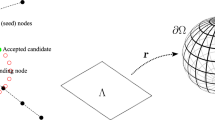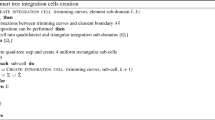Abstract
We describe a set of procedures for the shape reconstruction and mesh generation of unstructured high-order spatial discretization of patient-specific geometries from a series of medical images and for the simulation of flows in these meshes using a high-order hp-spectral solver. The reconstruction of the shape of the boundary is based on the interpolation of an implicit function through a set of points obtained from the segmentation of the images. This approach is favoured for its ability of smoothly interpolating between sections of different topology. The boundary of the object is initially represented as an iso-surface of an implicit function defined in terms of radial basis functions. This surface is approximated by a triangulation extracted by the method of marching cubes. The triangulation is then suitably smoothed and refined to improve its quality and permit its approximation by a quilt of bi-variate spline surface patches. Such representation is often the standard input format required for state-of-the-art mesh generators. The generation of the surface patches is based on a partition of the triangulation into Voronoi regions and dual Delaunay triangulations with an even number of triangles. The quality of the triangulation is optimized by imposing that the distortion associated with the energy of deformation by harmonic maps is minimized. Patches are obtained by merging adjacent triangles and this representation is then used to generate a mesh of linear elements using standard generation techniques. Finally, a mesh of high-order elements is generated in a bottom-up fashion by creating the additional points required for the high-order interpolation and projecting them on the edges and surfaces of the quilt of patches. The methodology is illustrated by generating meshes for a by-pass graft geometry and calculating high-order CFD solutions in these meshes.












Similar content being viewed by others
References
Aho A (1983) Data structures and algorithms. Addison-Wesley, Reading
Antiga L, Steinman DA (2004) Robust and objective decomposition and mapping of bifurcating vessels. IEEE Trans Med Imaging 23(6):704–713
Antiga L, Iordache BE, Caverni L, Cornalba GP, Remuzzi A (2002) Geometric reconstruction for computational mesh generation of arterial bifurcations from CT angiography. Comput Med Imaging Graph 26(4):227–235
Ayache N (1998) L’analyse automatique des images médicales. Êtat de l’art et perspectives. Technical report 3364, INRIA
Beatson RK, Light WA, Billings S (2000) Fast solution of the radial basis function interpolation equations: domain decomposition methods. SIAM J Sci Comput 22(5):1717–1740
Beatson RK, Cherrie JB, Ragozin DL (2001) Fast evaluation of radial basis functions: methods for four-dimensional polyharmonic splines. SIAM J Math Anal 32(6):1272–1310
Bloomenthal J (1994) An implicit surface polygonizer. In: Heckbert PS (ed) Graphics gems IV, Academic Press, London, pp 324–349
Buhmann MD (2003) Radial basis functions. Cambridge University Press, Cambridge
Burkard RE, Derigs U (1980) Assignment and matching problems: solution methods with FORTRAN programs. In: Lecture notes in economics and mathematical systems. Springer, Heidelberg
Carr JC, Beatson RK, Cherrie JB, Mitchell TJ, Fright WR, McCallum BC, Evans TR (2001) Reconstruction and representation of 3D objects with radial basis functions. In: Computer graphics proceedings, SIGGRAPH2001, pp 67–76
Cebral JR, Löhner R (2001) From medical images to anatomically accurate finite element grids. Int J Numer Methods Eng 51:985–1008
Chernyaev E (1995) Marching cubes 33: Construction of topologically correct isosurfaces. Technical report CERN-CN/95-17, CERN
Coppola G, Sherwin SJ, Peiró J (2001) Non-linear particle tracking for high-order elements. J Compuy Phys 172:356–380
Dey S, O’Bara RM, Shephard MS (1999) Curvilinear mesh generation in 3D. Comput Aided Des 33:199–209
Duncan M (1999) Applied geometry for computer graphics and CAD. Springer, Heidelberg
Eck M, Hoppe H (1996) Automatic reconstruction of B-spline surfaces of arbitrary topological type. In: Computer graphics proceedings, SIGGRAPH96, pp 325–334
Eck M, DeRose T, Duchamp T, Hoppe H, Lounsbery M, Stuetzle W (1995) Multiresolution analysis of arbitrary meshes. In: Computer graphics proceedings, SIGGRAPH95, pp 173–180
Eells J, Sampson J (1964) Harmonic mappings of Riemannian manifolds. Am J Math 86:109–160
Floater MS (1997) Parameterization and smooth approximation of surface triangulations. Comput Aided Geom Des 14:231–250
Frey PJ (2004) Generation and adaptation of computational surface meshes from discrete anatomical data. Int J Numer Methods Eng 60:1049–1074
Frey PJ, George PL (2000) Mesh generation. Hermes Science Publishing
Gambaruto A, Radaelli A, Peiró J, Doorly DJ (2008) Reconstruction of shape and flow in anatomical conduits. Int J Numer Methods Fluids 57(5):495–517
Giordana S (2004) Geometrical reconstruction from medical images, classification and modelling of arterial by-pass grafts. PhD thesis, Department of Aeronautics, Imperial College London
Giordana S, Sherwin SJ, Peiró J, Doorly DJ, Papaharilaou Y, Caro CG, Watkins N, Cheshire N, Jackson M, Bicknall C, Zervas V (2005) Automated classification of peripheral distal by-pass geometries reconstructed from medical data. J Biomech 38:47–62
Hartmann E (1999) On the curvature of curves and surfaces defined by normalforms. Comput Aided Geom Des 16:355–376
Jackson MJ, Bicknelland CD, Zervas V, Cheshire NJW, Sherwin SJ, Giordana S, Peiró J, Papaharilaou Y, Doorly DJ, Caro CG (2003) Three-dimensional reconstruction of autologous vein bypass graft distal anastomoses imaged with magnetic resonance: clinical and research applications. J Vasc Surg 38:621–625
Karniadakis GE, Israeli M, Orszag SA (1991) High-order splitting methods for the incompressible Navier-Stokes equations. J Comp Phys 97:414–443
Ladak HM, Milner JS, Steinman DA (2000) Rapid three-dimensional segmentation of the carotid bifurcation from serial MR images. J Biomech Eng 122:96–99
Lorensen WE, Cline HE (1987) Marching cubes: a high resolution 3D surface reconstruction algorithm. Comput Graph 21(4):163–169
McInerney T, Terzopoulos D (1996) Deformable models in medical image analysis: a survey. Med Image Anal 1(2):91–108
NEMA (2007) Digital imaging and communications in medicine (DICOM). http://medical.nema.org/dicom/2007/, maintained by the National Electrical Manufacturers Association
Okabe A, Boots B, Sugihara K (1992) Spatial tessellations. Concepts and applications of Voronoi diagrams. Wiley, London
Peiró J (1999) Surface grid generation. In: Thompson JF, Soni BK, Weatherill NP (eds) Handbook of grid generation. CRC Press LLC, Chap 19, pp 19.1–19.20
Peiró J, Sayma AI (1995) A 3-D unstructured multigrid Navier-Stokes solver. In: Morton KW, Baines MJ (eds) Numerical methods for fluid dynamics V, Oxford University Press, New York
Peiró J, Formaggia L, Gazzola M, Radaelli A, Rigamonti V (2007) Shape reconstruction from medical images and quality mesh generation via implicit surfaces. Int J Numer Methods Fluids 53:1339–1360
Peraire J, Morgan K, Peiró J (1993) Multigrid solution of the 3-D compressible Euler equations on unstructured tetrahedral grids. Int J Numer Methods Eng 36:1029–1044
Peraire J, Peiró J, Morgan K (1999) Advancing front grid generation. In: Thompson JF, Soni BK, Weatherill NP (eds) Handbook of grid generation, CRC Press LLC, Chap 17, pp 17.1–17.22
Russ JC (ed) (1999) The image processing handbook, 3rd edn. CRC Press with IEEE Press
Sethian JA (1999) Level set methods and fast marching methods, 2nd edn. Cambridge University Press, London
Sherwin SJ, Karniadakis GE (1996) Tetrahedral hp finite elements: algorithms and flow solutions. J Comput Phys 124:14–45
Sherwin SJ, Peiró J (2000) Mesh generation in curvilinear domains using high-order elements. Int J Numer Methods Eng 53:207–223
Sonka M, Fitzpatrick JM (eds) (2000) Handbook of medical imaging, medical image processing and analysis, vol 2. SPIE press, Whashington
Tarjan RE (1983) Data structures and network algorithms. In: CMBS-NSF regional conference series in applied mathematics, SIAM
Thompson JF, Soni BK, Weatherill NP (eds) (1999) Handbook of grid generation. CRC Press LLC
Turk G, O’Brien JF, Yngve G (2001) Implicit surfaces that interpolate. In: Shape modelling international, Genova, Italy
Wendland H (2002) Fast evaluation of radial basis functions: methods based on partition of unity. In: Chui CK, Schumaker LL, Stockler J (eds) Approximation theory X: wavelets, splines, and applications. Vanderbilt University Press, Nashville, pp 473–483
Wolters BJBM, Rutten MCM, Schurink GWH, Kose U, de Hart J, van de Vosse FN (2005) A patient-specific computational model of fluid-structure interaction in abdominal aortic aneurysms. Med Eng Phys 27:871–883
Zhang Y, Bazilevs Y, Goswami S, Bajaj CL, Hughes TJR (2007) Patient-specific vascular NURBS modelling for isogeometric analysis of blood flow. Comput Methods Appl Mech Eng 196:2943–2959
Acknowledgments
We would like to thank some of the past and present members of the Biofluids group: Denis Doorly, Donal Taylor, Alberto Gambaruto, Kuan-Lok “Adrian” Lee and Alessandro Radaelli, for contributing with ideas and material to this paper.
Author information
Authors and Affiliations
Corresponding author
Rights and permissions
About this article
Cite this article
Peiró, J., Sherwin, S.J. & Giordana, S. Automatic reconstruction of a patient-specific high-order surface representation and its application to mesh generation for CFD calculations. Med Biol Eng Comput 46, 1069–1083 (2008). https://doi.org/10.1007/s11517-008-0390-3
Received:
Accepted:
Published:
Issue Date:
DOI: https://doi.org/10.1007/s11517-008-0390-3




